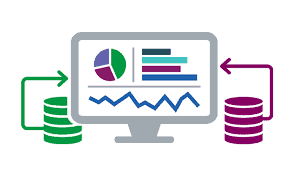
Companies that want the real value data provides will need robust data tools and a platform designed to democratize data across the enterprise.
Companies know that the data revolution will determine which businesses thrive in the new technological age and which are forgotten—no pressure or anything.
In truth, businesses feel pressured to move beyond data competence and into a new realm of data-driven operation. They want to leverage data—not merely collect and store data. But current systems make it difficult to unlock the value data has promised.
Data can enhance a business’s positioning and improve revenue by providing deep insight into market trends and customer behavior. If that data is locked up behind mysterious data lakes and only accessible to data scientists, your data can’t and won’t deliver.
A monumental shift must happen in the way we deliver and disseminate data. What’s needed is a democratization that balances access with security. For a business to be data-driven, everyone must have the data they need through a company-wide data culture.
What it means to have a data culture
According to a survey by NewVantage Partners, companies are embracing analytics and even artificial intelligence-driven initiatives. Still, few are taking the next steps towards a fully integrated, data-driven culture. The survey found that nearly all respondents recognized the need to build a data-driven culture, but just a third of respondents from established firms had managed to do so.
For a business to realize the true potential of data, companies need a pervasive use of data and analysis. Accomplishing this means shifting all departments cohesively towards utilizing insights from data and building data-driven decisions into day-to-day operations.
If you’re lucky enough to have a data science team already, you’ve watched this happen departmentally. Move that mode of operation to the rest of the company, and you’ve accomplished the first steps toward adopting a company-wide data culture.
- C-suite and other decision-makers must decide to rely on data insights to drive business decisions, both large and small, helping direct questions and receive feedback.
- Departmental employees follow this lead, implementing data into day-to-day operations, contributing inquiries from their specific perspective, and facilitating the transfer of data to the appropriate place in the pipeline.
- Data scientists and engineers build the infrastructure and algorithms to harness, store, and move data to the appropriate place, providing the story and interpreting results with department leads and decision-makers’ expertise.
With a robust pipeline like this, data becomes a living thing, not just storage. The movement of data and its rapid analysis secures insights in real-time or near real-time and forms the foundation for better, more efficient decisions.
Three key components to true data connection
The tools necessary for data analysis are faster, smarter, and more accessible. Data that’s segmented in different departments or residing in cemented silos isn’t a full picture of your insights. If you want to get the rich picture data can offer, you must create a culture of data connection.
1) Infrastructure: With the right infrastructure or even data fabric, you’ll have your data pipeline in place with everyone ready at their access points. One big hurdle to adopting a company-wide data culture is the lack of tools and the right platform.
Companies holding into legacy systems are only holding themselves back and creating potential security risks. It’s difficult to view data in its entirety and create a cohesive governance strategy if tools and solutions are a hodgepodge of separate systems.
Instead, companies must look into converting to a cohesive system that supports artificial intelligence to understand the full picture of data and provide the governance solutions they need to disseminate data across departments.
2) Governance: Everyone gets access and ownership, but at different stages and levels assigned strategically. Using your new data tools, you can disseminate the data departments need, while also tracking who has access to sensitive information, who makes what changes, and how data flows from one pipeline segment to the next.
Such capabilities are critical to help deal with regulatory and compliance issues. Robust tools designed for layperson use—not just data scientists—can help organizations prepare for audits, track vulnerabilities, and implement new governance strategies.
The tools themselves should make those policies more comfortable to implement with intelligent access, continual monitoring, and robust dashboard controls. An integral part of the governance process will be choosing tools that facilitate customization and consistency.
3) Buy-in: Everyone in your organization must understand and embrace a data-driven culture. Newer generations of employees are increasingly more comfortable working within these systems, but you cannot rely on that to build your company culture.
To ensure that a company has the support for data-driven culture, it can:
- Invest in continuing education for data literacy
- Cultivate talent within the organization, regardless of department
- Establish a set of metrics that matter not only to data scientists but to each department as well
- Clearly state the benefits of converting to data-driven decision-making to the individual and department
- Adopt a top-down approach (C-suite and department leaders must be data-driven themselves)
Pervasive data and analysis is the way forward
Companies that want the real value data provides will need robust data tools and a platform designed to democratize data across the enterprise. With everyone working on the same data pipeline, data scientists will be able to move beyond storing data to building a truly innovative company culture.
Take data out of the silos and put it to work in motion. The right tools and cohesive platform give you the chance to nail down governance and secure data through an infrastructure approach. Your employees will have solutions that work, boundaries that protect them and the company, and may find once and for all the power that real data insights offer.
Read the other blogs in this series:







